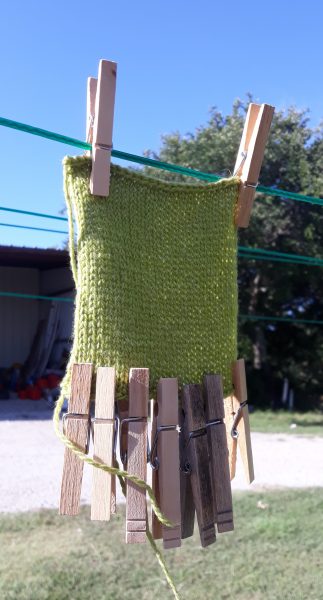The pattern I’m test knitting calls for DK weight yarn, something that’s 50% non-stretchy/bouncy yarn. Laura Aylor, the designer, suggested 50% plant fiber. I’m using a yarn that’s 50% wool, 25% cotton, 15% linen and 10% silk.
When knitting anything that has to fit, gauge is so important. For something like a shawl, gauge isn’t horribly important as far as fit. It is important as far as knowing how much yarn you’re going to use. When I’m making socks, especially basic socks, I can look at the yarn and know what size needles to use and how many stitches to cast on.
For sweaters, it’s a bit tedious to get the exact gauge. Gauge is usually given in 4″ measurements because 4″ gives you a more accurate measurement than measuring 1″ and multiplying that by 4.
If the pattern indicates gauge is 24 stitches/4″ (or 6 stitches per inch) just a few stitches off can make a huge difference. Suppose I need a 40″ bust. For the given 24 stitches/4″, I would need 240 stitches to have a 40″ bust. (40″ divided by 4″ = 10 and 10 x 24″ = 240 stitches).
Suppose my gauge is 26 stitches per 4 inches. 40″ divided by 4″ = 10 and 10 x 26 = 260 inches so that means I would need 260 stitches to give me a 40″ bust but the pattern thinks I need 240 stitches so my sweater is going to be too small, or about 37″.
Suppose my gauge is 22 stitches per 4 inches. 40″ divided by 4″ = 10 and 10 x 22 = 220 inches so that means I would need 220 stitches to give me a 40″ bust but the pattern thinks I need 240 stitches so my sweater is going to be too big. 220 stitches would equal 40″ but with 240 stitches (pattern), the sweater would have a 43.6″ bust.
So, you can see the importance of getting the right gauge or, doing a bit of math to make the sweater fit as needed. Suppose I have that 22″ gauge and I know I need 260 stitches to get the bust size I need, I can do the math and use the size that would have 260 stitches in the bust and it should it.
Since this is a test knit, I need to follow the pattern exactly or I wouldn’t be helping the designer.

I’m a loose knitter so I almost always go down a needle size to get gauge. This pattern suggested a 3.75 mm needle. I started with a 3.50 mm needle.
Because of the cotton/linen content in this yarn, the weight is going to pull it down and make it a bit longer so just before my swatch was completely dry, I hung it outside with clothespins to give it a little weight at the bottom. Once it was dry, I measured the stitches. I needed 21 stitches per row and I was right about 21.5 stitches, which tells me my sweater will be just a bit smaller than I needed for it to be.
I’ve been trying to practice using a bit more tension so maybe I no longer need to go down a needle size. My row gauge was WAY off. The pattern calls for 26 rounds and I had 32 rows. That’s a huge difference and it isn’t so crucial except from the neck down to the underarms, in most cases. Most of the time, the pattern will say something like “knit 8 inches” or something like that so it doesn’t matter so much about row gauge except from the neck to where I separate off the sleeves.
So, I have to get that row gauge closer to correct. I ended up making a second swatch using 3.75 mm needles, the size suggested. It’s drying now so I can see how it measures out. Waiting for the swatch to dry has given me time to finish the socks, which was my original plan so, it’s all working out fine.
By tonight I’ll be able to start the sweater.

Nelle Coursey says
I love this color! I finally finished my Wings shawl but have not blocked it yet. Nor have I taken pictures of it. I think I need to go to a needle size larger.
dezertsuz says
The yarn is a really pretty color. I hope it makes a beautiful sweater for you and the pattern fits perfectly!